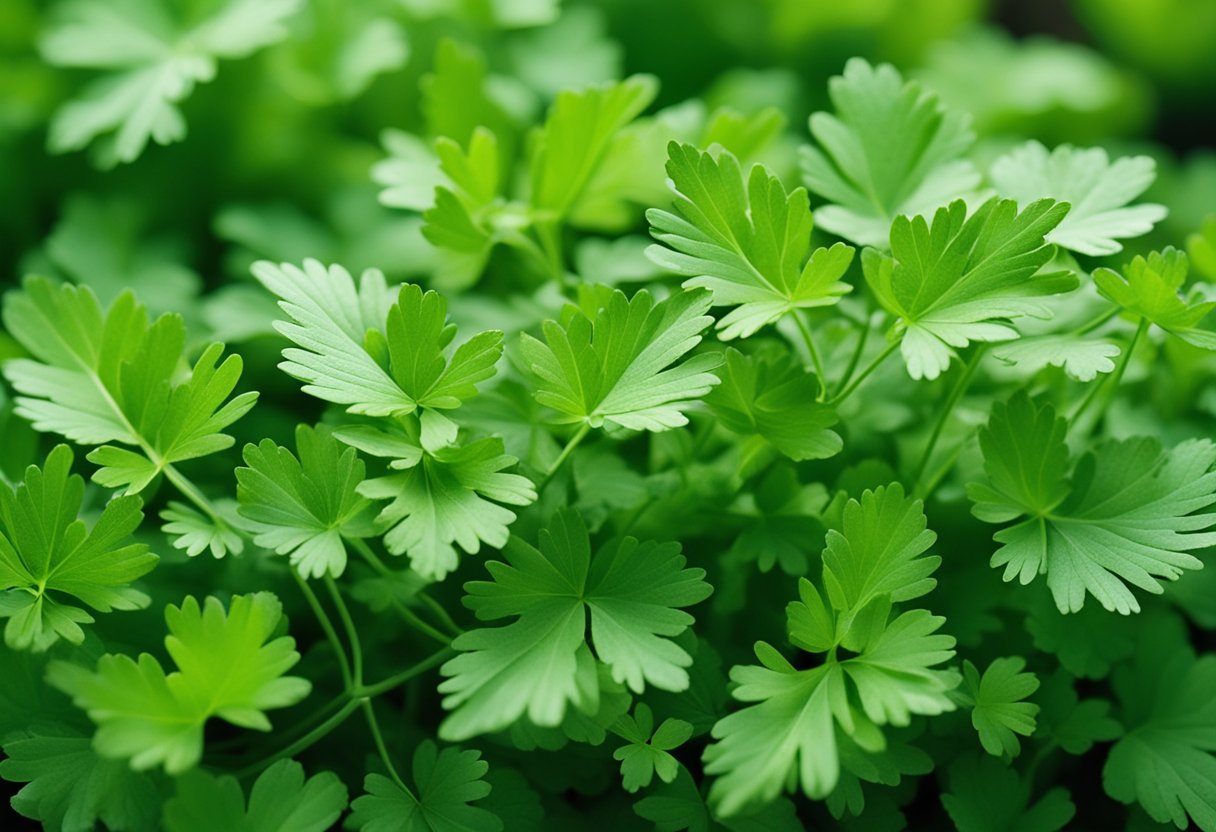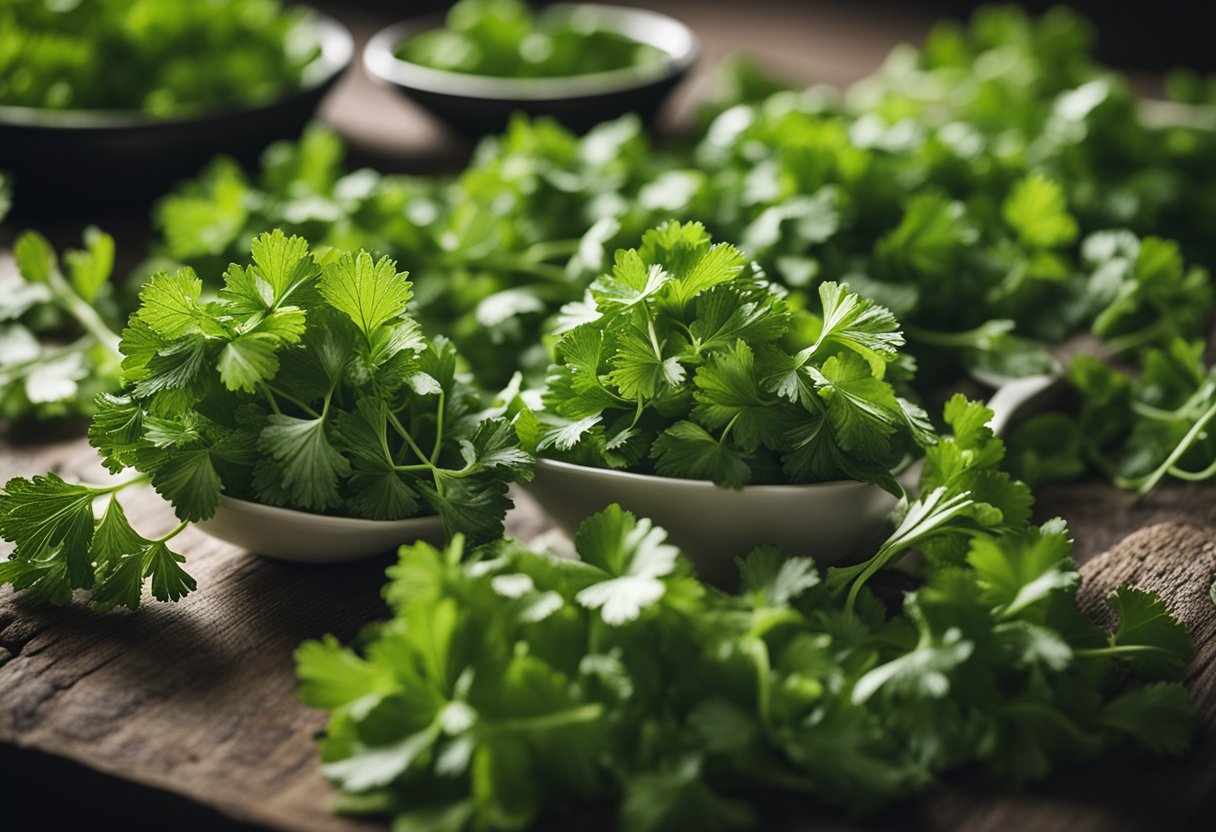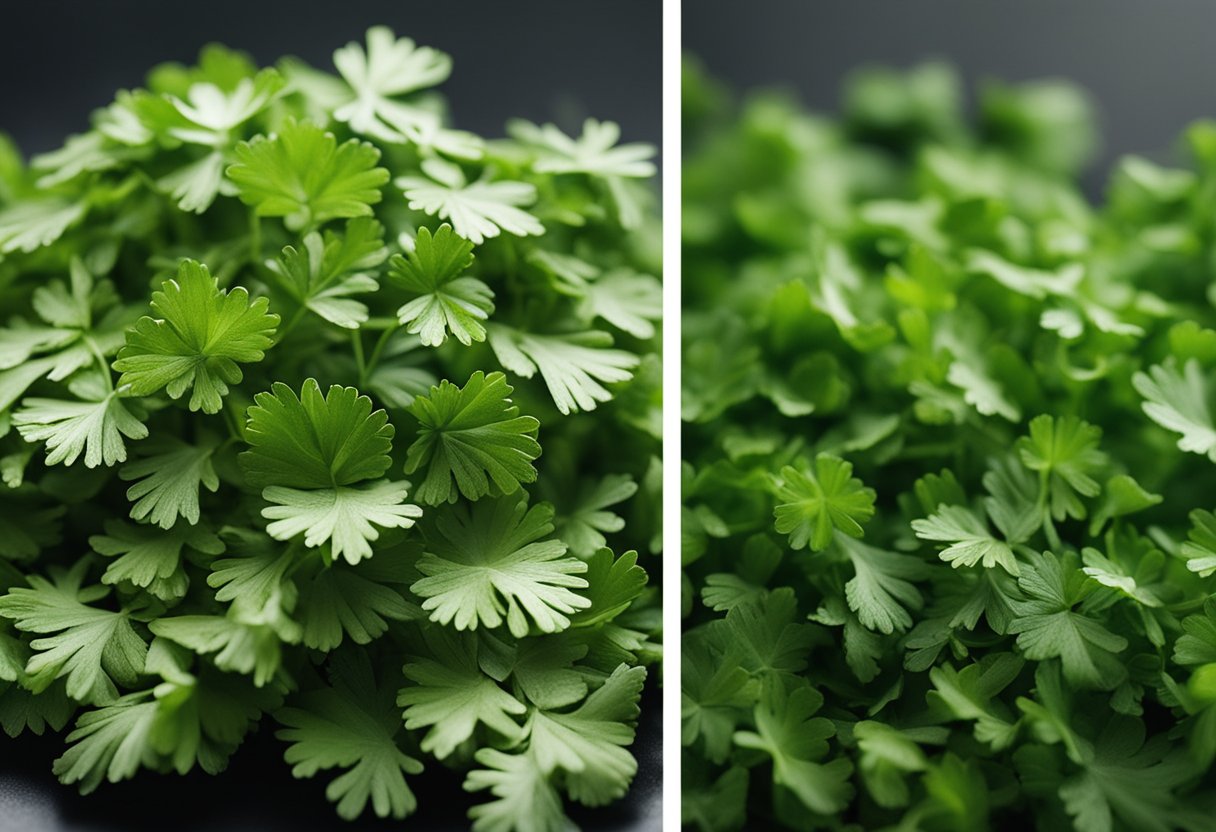As a home cook, I often find myself reaching for cilantro to add a fresh and zesty flavor to my dishes. However, sometimes I don’t have fresh cilantro on hand and wonder if I can substitute dried cilantro instead.
This led me to wonder, what is the difference between dried cilantro vs fresh cilantro, and can they be used interchangeably?

Cilantro, also known as coriander in some countries, is a popular herb used in many cuisines around the world. It has a unique flavor profile that is described as citrusy, slightly sweet, and sometimes soapy.
While fresh cilantro is widely available in grocery stores, dried cilantro is also a common ingredient in many spice cabinets. But how do they compare in terms of flavor, nutrition, and cooking uses?
Fresh cilantro is known for its pungent aroma and strong flavor, which can add depth and complexity to dishes.
On the other hand, dried cilantro has a more muted flavor and aroma, making it a good option for those who find fresh cilantro too overpowering.
But can dried cilantro be used as a substitute for fresh cilantro in recipes? Let’s take a closer look at the differences between dried cilantro vs fresh cilantro.
Key Takeaways
- Fresh cilantro has a stronger flavor and aroma than dried cilantro.
- Dried cilantro can be a good option for those who find fresh cilantro too overpowering.
- While dried cilantro can be used as a substitute for fresh cilantro in some recipes, it’s important to note that the flavor and texture may not be exactly the same.
Understanding Cilantro
As someone who loves to cook, I know that herbs can make or break a dish. One herb that I often use is cilantro, which is also known as coriander.
Cilantro is a leafy herb that comes from the coriander plant. It is widely used in Latin American, Caribbean, and Asian cuisines.
Cilantro has a unique flavor that is often described as citrusy and slightly spicy. Some people love it, while others can’t stand it. The flavor of cilantro comes from the essential oils in the leaves, which are most potent when the herb is fresh.
Although cilantro is often used interchangeably with coriander, they are not the same thing. Coriander refers to the seeds of the coriander plant, which have a different flavor than the leaves. Coriander seeds are often used in spice blends and marinades.
When it comes to using cilantro in cooking, there are two forms to choose from: fresh cilantro and dried cilantro.
Fresh cilantro is the most flavorful and is best used in dishes that require a fresh, bright flavor. Dried cilantro, on the other hand, has a more muted flavor and is best used in dishes where the cilantro flavor is not the star of the show.
It’s important to note that dried cilantro cannot fully replicate the flavor of fresh cilantro. The essential oils in the leaves that give cilantro its unique flavor are lost during the drying process.
As a result, dried cilantro has a weaker flavor and aroma than fresh cilantro.
In summary, cilantro is a versatile herb that can add a unique flavor to a wide variety of dishes. Whether you choose to use fresh cilantro or dried cilantro depends on the dish you are making and the flavor profile you are trying to achieve.
Fresh Cilantro: An Overview
Fresh cilantro, also known as coriander, is a popular herb used in various cuisines worldwide. It is well-known for its bright green leaves that add a burst of flavor to any dish.
Fresh cilantro is commonly used as a garnish in many dishes, including salads, soups, and stews.
In Latin American cuisine, fresh cilantro is a staple ingredient in dishes such as salsa and guacamole. The herb adds a fresh, zesty taste to these dishes, making them more flavorful and enjoyable.
Middle Eastern cuisine also utilizes fresh cilantro in many dishes, including salads and dips. The herb’s unique flavor complements the spices used in Middle Eastern cuisine, creating a harmonious and delicious taste.
In Thai cuisine, fresh cilantro is used to add a fresh, herbal flavor to many dishes. It is often used in soups, curries, and stir-fries, adding a unique taste to these dishes.
In American cuisine, fresh cilantro is becoming more popular as people experiment with different flavors and ingredients. It is often used in Tex-Mex dishes, adding a fresh, zesty taste to these dishes.
Overall, fresh cilantro is a versatile herb that adds a burst of flavor to any dish. Whether you are making salsa, salads, or soups, fresh cilantro is an excellent choice to enhance the taste of your dish.
Dried Cilantro: An Overview
As a spice, dried cilantro is a popular choice for adding flavor to various dishes. It is made from the leaves of the coriander plant, which is also known as cilantro.
Dried cilantro is a convenient alternative to fresh cilantro as it has a longer shelf life and can be stored for a longer period of time.
One of the main benefits of dried cilantro is its longer shelf life. Unlike fresh cilantro, which can spoil quickly, dried cilantro can be stored for several months.
This makes it a great option for those who want to have cilantro on hand but do not want to constantly buy fresh cilantro.
Dried cilantro is also a great spice to have in your pantry as it can be used in a variety of dishes. It has a slightly different flavor profile than fresh cilantro, but it still adds a unique and delicious taste to any dish. It can be used in soups, stews, marinades, and more.
It is important to note that dried cilantro is not the same thing as coriander spice. Coriander spice is made from the seeds of the coriander plant and has a different flavor profile than dried cilantro.
However, both spices can be used in similar dishes and complement each other well.
Overall, dried cilantro is a great spice to have in your pantry. It has a longer shelf life than fresh cilantro and can be used in a variety of dishes.
While it may not have the exact same flavor profile as fresh cilantro, it still adds a unique and delicious taste to any dish.
Comparison of Flavors
Fresh cilantro has a strong, fragrant, and slightly peppery taste that adds a distinct citrus-like flavor to dishes. On the other hand, dried cilantro has a milder flavor with a slightly peppery taste.
The flavor of dried cilantro is less intense than fresh cilantro, and it doesn’t have the same pungent aroma.
When it comes to cooking, fresh cilantro is often used as a garnish or added to dishes at the end of cooking to preserve its flavor. Dried cilantro, on the other hand, is often used in spice blends and marinades to add a subtle flavor.
It’s important to note that some people find fresh cilantro to taste like soap, which can be attributed to a genetic variation. If you’re one of those people, dried cilantro may be a better option for you.
In general, both fresh and dried cilantro have their uses, and the choice between the two comes down to personal preference and the dish you’re preparing.
If you want a more intense flavor, go for fresh cilantro. If you’re looking for a milder flavor, dried cilantro is the way to go.
Uses in Cooking
When it comes to using cilantro in cooking, both dried and fresh forms have their place. Dried cilantro is a great option for recipes that require longer cooking times, such as soups, stews, and casseroles.
Since the flavor of dried cilantro is more concentrated than fresh, you can use less of it to achieve the same flavor.
Fresh cilantro, on the other hand, is best used in recipes that require a fresh, bright flavor. It is perfect for Mexican dishes, curries, and chimichurri sauce. Fresh cilantro is also great as a garnish or added to salads for an extra burst of flavor.
When using dried cilantro in recipes, it is important to add it at the beginning of the cooking time so that it has enough time to release its flavor.
This is especially important in marinades and sauces where the cilantro flavor needs to infuse the dish.
In terms of substitutions, you can use two tablespoons of dried cilantro instead of four tablespoons of fresh cilantro. However, it is important to note that the flavor of dried cilantro is not as pungent as fresh cilantro, so the resulting dish may have a milder flavor.
Overall, both dried and fresh cilantro have their place in cooking, and it ultimately comes down to the recipe and personal preference.
Substituting One for the Other
When it comes to substituting dried cilantro for fresh cilantro, there are a few things to keep in mind. While dried cilantro can be used as a substitute for fresh cilantro, it’s important to remember that the flavor won’t be quite the same.
If you’re substituting dried cilantro for fresh cilantro, you can use about half the amount of dried cilantro as you would fresh cilantro.
For example, if a recipe calls for four tablespoons of fresh cilantro, you can add two tablespoons of dried cilantro instead. Keep in mind that the flavor of dried cilantro is milder than fresh cilantro, so you may need to adjust the amount to taste.
If you don’t have any cilantro on hand, there are several substitutes you can use. Parsley, basil, celery leaves, and dill are all good alternatives to fresh cilantro. These herbs have a similar flavor profile to cilantro and can be used in the same way.
If you’re making bean dips or seasoning blends, you may want to consider using culantro instead of cilantro. Culantro has a similar flavor to cilantro, but it’s stronger and more pungent. It’s a popular ingredient in Latin American and Caribbean cuisine.
When substituting one herb for another, it’s important to keep in mind that the flavor profile may be slightly different. However, with a little experimentation, you can find the perfect substitute for your recipe.
Nutritional Differences
When it comes to nutritional differences between fresh cilantro and dried cilantro, there are some things to consider. While both forms of cilantro offer health benefits, there are some variations in the nutrients they provide.
First of all, fresh cilantro is a good source of vitamins and minerals. It contains high levels of vitamin K, vitamin C, and vitamin A, as well as potassium, manganese, and antioxidants. Vitamin K is essential for blood clotting, while vitamin C is important for immune system function and skin health.
Vitamin A is crucial for eye health and immune system function, while potassium helps regulate blood pressure and heart function. Manganese is important for bone health, and antioxidants help protect the body against damage from free radicals.
On the other hand, dried cilantro does not contain as many nutrients as fresh cilantro. The drying process can cause some of the vitamins and minerals to break down or be lost, so dried cilantro may not be as nutritious as fresh cilantro.
However, dried cilantro does still contain some vitamins and minerals, so it can still be a good addition to a healthy diet.
Overall, while fresh cilantro is more nutritious than dried cilantro, both forms of cilantro can offer health benefits. It is important to include a variety of fresh herbs and spices in your diet to ensure that you are getting a range of nutrients.
Price and Availability

When it comes to price and availability, there are some differences between dried cilantro and fresh cilantro.
Fresh cilantro is often more widely available than dried cilantro, as it is a common herb used in many cuisines. However, fresh cilantro can also be more expensive than dried cilantro, especially if it is out of season or not locally grown.
Dried cilantro, on the other hand, is generally more affordable and easier to find year-round. It is also a good option for those who do not have access to fresh cilantro or who prefer the convenience of dried herbs.
It is worth noting that the price and availability of both fresh and dried cilantro can vary depending on where you live and where you shop. It is always a good idea to compare prices and shop around to find the best deal.
Overall, whether you choose fresh or dried cilantro will depend on your personal preferences, budget, and availability. Both options have their pros and cons, and it ultimately comes down to what works best for you and your cooking needs.
Final Thoughts

In conclusion, the difference between dried and fresh cilantro is quite significant. Fresh cilantro has a more pronounced flavor compared to dried cilantro. It adds a vibrant and herbaceous taste to dishes, and it is more versatile in culinary uses.
On the other hand, dried cilantro has a weak cilantro flavor, and it is not a very good choice if you want to reach the strong flavor of the fresh cilantro in your dishes.
In terms of appearance, fresh cilantro has bright green leaves, while dried cilantro has a dull green color. As for texture, fresh cilantro is soft and pliable, while dried cilantro is brittle and crumbly.
When it comes to mouthfeel, fresh cilantro has a juicy and crunchy texture, while dried cilantro has a dry and powdery texture.
When using fresh cilantro, it is important to note that the stems are edible, but they have a stronger flavor than the leaves. Therefore, it is recommended to chop the stems finely and use them sparingly.
On the other hand, when using dried cilantro, it is best to rehydrate it by soaking it in water for a few minutes before using it in your recipe.
Overall, it is important to choose the right type of cilantro depending on your recipe and personal taste preferences.
Fresh cilantro is best for dishes that require a strong and fresh flavor, while dried cilantro is suitable for dishes that require a mild cilantro flavor.
Related posts:
Frequently Asked Questions
What are the differences between dried cilantro and fresh cilantro?
Dried cilantro is the result of fresh cilantro being dried and then ground into a powder. Fresh cilantro has a more pronounced flavor compared to dried cilantro.
It adds a vibrant and herbaceous taste to dishes. Dried cilantro, on the other hand, has a weaker cilantro flavor.
How does the taste of dried cilantro compare to fresh cilantro?
Fresh cilantro has a strong lemony and slightly peppery flavor, which some people find to taste a kind of soapy, whereas dried cilantro is with a weak cilantro flavor.
While the flavor of dried cilantro is similar in some ways to fresh cilantro, the pungency is considerably muted.
Can dried cilantro be substituted for fresh cilantro in recipes?
Yes, dried cilantro can be used as a substitute for fresh cilantro. A general rule of thumb is to use about one-third of the amount of dried cilantro compared to fresh cilantro.
For example, if a recipe calls for 3 tablespoons of fresh cilantro, you would use approximately 1 tablespoon of dried cilantro as a substitute.
Does dried coriander have a different taste than fresh cilantro?
Dried coriander, which is the seed of the cilantro plant, has a different taste than fresh cilantro. While the two are related, they have different flavor profiles.
Dried coriander has a warm, slightly sweet, and citrusy flavor, whereas fresh cilantro has a bright, herbaceous, and slightly bitter taste.
What are the benefits of using fresh cilantro over dried cilantro?
Fresh cilantro is known for its pungent aroma, and while the flavor of its dried form is similar in some ways, the pungency is considerably muted.
Fresh cilantro also contains more nutrients than dried cilantro, including vitamin C, vitamin K, and potassium. Additionally, fresh cilantro adds a vibrant and herbaceous taste to dishes.
How much dried cilantro should be used to replace 1 tablespoon of fresh cilantro?
A typical bunch of fresh cilantro weighs around 1 ounce or 28 grams. Therefore, you would use approximately 1/3 ounce or 9 grams of dried cilantro as a substitute for 1 tablespoon of fresh cilantro.







